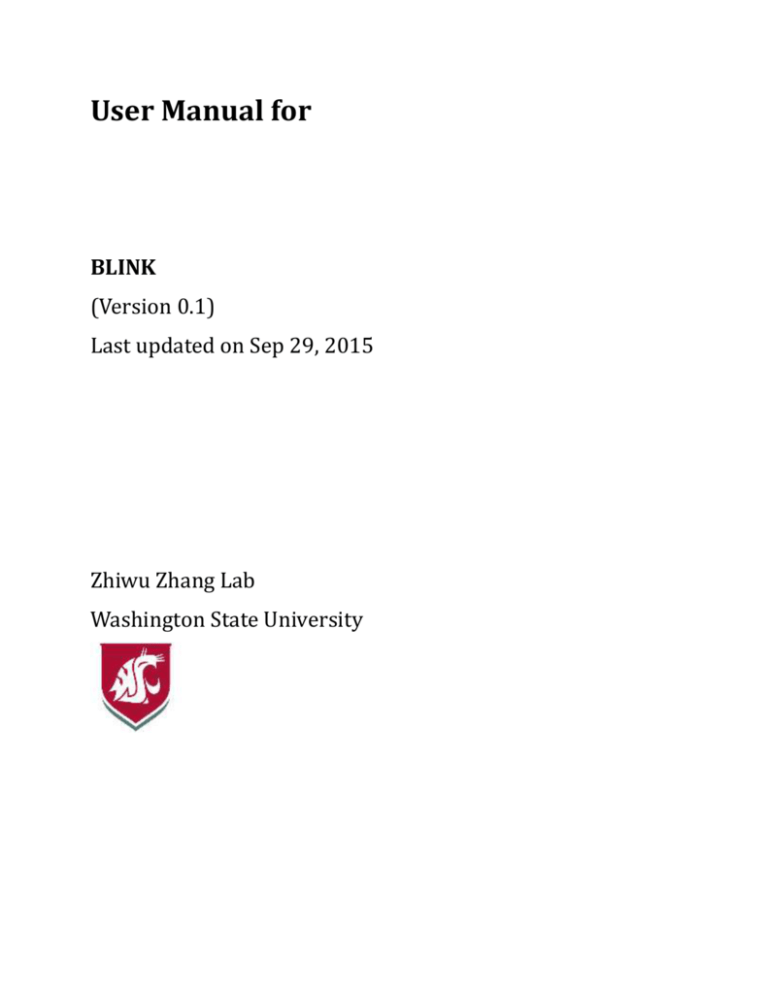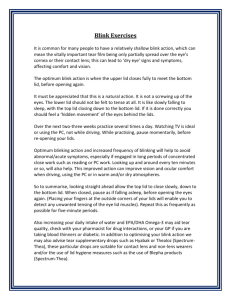User manual
advertisement

User Manual for
BLINK
(Version 0.1)
Last updated on Sep 29, 2015
Zhiwu Zhang Lab
Washington State University
BLINK User Manual
Disclaimer: This software is provided “as is”, with no warranty of any kind, expressed or
implied and in no event will the developers be liable for direct, indirect, incidental or
consequential damages resulting from use of the software.
Support documents: Extensive support documents, including this user manual, source
code, demonstration scripts, data, and results, are available at BLINK website from Zhiwu
Zhang Laboratory: http://zzlab.net/blink
Supported operating system: Windows, Mac, and Linux (x86_64)
Leading author: Meng Huang
Contributors: Xiaolei Liu and Ryan Summers
Questions and comments: Users and developers are recommended to post questions and
comments to BLINK forum:
https://groups.google.com/forum/#!forum/biogpu
2
BLINK User Manual
Contents
1
INTRODUCTION
5
2
GETTING STARTED
6
2.1
2.2
2.3
2.4
3
3.1
3.2
4
4.1
4.2
5
5.1
5.2
OPEN COMMAND LINE WINDOW
DOWNLOAD BLINK
DOWNLOAD INPUT FILES
RUN BLINK
6
6
6
7
PHENOTYPE FILE
8
FORMAT
MISSING VALUES
8
8
GENOTYPE FILE FORMAT AND CONVERSION
GENOTYPE FORMATS
FORMAT CONVERSION
9
9
10
GWAS
12
WORKING WITH DIFFERENT GENOTYPE FORMATS
CHANGING OUTPUT FILE NAME
12
12
6
GENOMIC PREDICTION
13
7
ADVANCED OPERATIONS
14
7.1
7.2
7.3
7.4
8
MEMORY SAVING
PARALLEL COMPUTATION
SPECIFYING A TRAIT
OPTIMIZATION
14
14
14
14
APPENDIX
17
3
BLINK User Manual
8.1 TUTORIAL DATA SETS
8.2 FREQUENTLY ASKED QUESTIONS
1. WHY DO I USE BLINK?
2. HOW DO I CITE BLINK?
8.3 BLINK BIOGRAPHY
9
17
17
17
17
17
REFERENCES
18
4
BLINK User Manual
1 Introduction
The performance of computing tools for genome-wide association studies (GWAS) are
measured by their computing speed, memory requirements, and statistical power1. These
three factors are determined by the statistical methods a tool implemented and how these
methods are engineered to make full use of computer hardware resources. We developed a
computing tool named BLINK that implements a new statistical method. BLINK effectively
controls false positives caused by population structure and unequal relatedness among
individuals and improves statistical power - even when compared to mixed linear model
methods. The BLINK method requires much less complex computing time, nearly matching
the linear computing time complexity of the general linear model. BLINK was written in C
computer language to maximize the capability of direct electronic circuit operations,
including binary formatting of genotype input files and bit operations for matrix
manipulations. To further increase computing speed, BLINK was developed with parallel
computational capacity, so that computing times decrease linearly with the number of
central processing units. Furthermore, the parallel components are dissected small enough
so that graphic processing units are also able to perform parallel computations. To solve the
memory footprint bottleneck, BLINK allows users to directly control memory usage when
big data are analyzed on computers with limited memory. That is, users have the option to
trade computing time for less memory usage. Based on these features above, BLINK makes
analyses of large and complex datasets feasible without supercomputers.
5
BLINK User Manual
2 Getting started
2.1 Open command line window
BLINK use Command-Line Interface (CLI). In Mac, the application is called Terminal. From
Applications window, click Utilities and then Terminal.
In Windows, the application is called Command Prompt. From search window, input “cmd”
and then choose it from results.
In Linux (Ubuntu), the application is also called Terminal. From search window, input
“terminal” and then choose it from results.
2.2 Download BLINK
The BLINK executable program (BLINK) can be download at http://ZZLab.net/blink. Create
a folder on your hard disk, for example, myBLINK and save the BLINK executable program
in the folder.
2.3 Download input files
Go to http://ZZLab.net/blink and download the demo data, then copy all the files including
data and BLINK executable program to the same folder (e.g. myBLINK).
6
BLINK User Manual
NOTE: Although most of the file have the same format as GAPIT2 and TASSEL3, differences
do exist.
2.4 Run BLINK
Users need to specify the pathway and names of BLINK executable file and input files. A
convenient way is to change current pathway to the one containing these files. This can be
done with this command in the Terminal:
cd /users/Zhiwu/myBLINK
To perform GWAS between phenotype and one of the genotype formats, for example the
compress format, type the following command:
blink --gwas --file myData --binary
There are five input files involved in this analyses: myData.pre, myData.pos, myData.val,
myData.map, and myData.txt. UNIX operating system (e.g. Mac and Ubuntu) may require
adding “./” in front of these commmand lines to specify the current directory.
7
BLINK User Manual
3 Phenotype file
3.1 Format
Phenotype file is coded as text file with extension of “txt”. The file name must be the same
as genotype file(s) so they can be analyzed together. BLINK supports multiple traits. The
first column is reserved for individual name. Each trait occupies one column. The first row
is reserved as the header of each column. The following figure demonstrates the first eight
rows of the phenotype file from the demonstration dataset.
The individuals have to be in the same order as the genotype data.
3.2 Missing values
Missing data are allowed in phenotype data. Missing data in genotype can be any character
(such as N, NA, or NaN) except numerical number and decimal. But missing data in
phenotype should only be “NaN”. Traits are analyzed independently. None missing values of
each trait are matched with genotype for each trait.
NOTE: When the trait has missing value and do GWAS
8
BLINK User Manual
4 Genotype file format and conversion
4.1 Genotype formats
BLINK currently supports five types of genotype formats: compress, numeric, hapmap, vcf
and plink. The files must have the same name for each format except the extension names.
The compress format is the working format to perform analyses. All the other formats are
converted to compress format before the analyses. The compress format has four files.
Their extensions are pre, pos, val and map. “pre” and “pos” are coded as binary files
containing genotype data. The other two are coded as text. “val” store the inter product of
each marker. “map” is the map information of markers, including marker name,
chromosome and base pair position. These four files must be used together for the
compress format.
The numeric format has two file extensions: dat and map. The file with extension “dat”
contains genotype data. The other file has extension of “map”, which is the same as the map
file of the compress format. These two files must be used together for the compress format.
The plink binary format also has three file extensions: .bed, .bim, and .fam. Please find detail
of plink format at http://pngu.mgh.harvard.edu/~purcell/plink/data.shtml#bed
The hapmap and vcf file only have one file each. They are both coded as text. The genotype
in hapmap format has extension of “hmp”. The genotype in vcf format has extension of
“vcf”.
The relationship between genotype formats and file extensions are summarized in
following table:
Extension
pre
pos
val
dat
map
hmp
vcf
bin
ped
Code
binary
binary
text
text
text
text
text
binary
binary
compress
x
x
x
x
numeric
hapmap
vcf
plink
x
x
x
x
x
x
9
BLINK User Manual
4.2 Format conversion
BLINK uses compress genotype format by default as working data format to perform
analyses efficiently. BLINK supports other genotype formats by converting them to
compress format first. BLINK also supports converting compress format to other genotype
formats, including numeric, hapmap, and VCF. See diagram below:
BLINK uses --recode option to convert compress format to other formats except PLINK
format:
blink --file myData --recode --out newdata --numeric
blink --file myData --recode --out newdata --hapmap
blink --file myData --recode --out newdata --vcf
The option of “--out” is used to specify the name of output of the converted genotype
format. When it is omitted, the default uses the name of input.
NOTE: When we use recode function, all the four compressed format files and phenotype
file should be exist in the same folder and with same name (e.g. myData.pre, myData.pos,
myData.val, myData.map, myData.txt). All the missing information will be filled with “NA”.
BLINK also can convert other formats (numeric, HapMap, VCF and PLINK) to compress
format without performing additional analyses by using “--compress” option:
blink --file myData --compress --numeric
blink --file myData --compress --hapmap
blink --file myData --compress --vcf
blink --file myData --compress --plink
10
BLINK User Manual
4.3 Covariance format
The covariance will be saved row by row with out title and ID into the text file. Different
row means different covariance and different column means different individuals. When
you want to add covariance into model, just keep its file name same as genotype files and
with the extension “.cov” (e.g. myData.cov), then put them into same folder and do GWAS
analysis.
11
BLINK User Manual
5 GWAS
Both phenotype and genotype files are required to perform GWAS. These files must share a
common name with different extensions specified by phenotype and different genotype
formats. Analyses of GWAS is specified with “--gwas” option.
5.1 Working with different genotype formats
To perform GWAS with BLINK on one of the genotype formats, type the one of the
corresponding file format:
blink --gwas --file myData --binary
blink --gwas --file myData --numeric
blink --gwas --file myData --hapmap
blink --gwas --file myData --vcf
blink --gwas --file myData --plink
The GWAS result contains map information of the marker and corresponding p values. The
output file is named by the trait name followed by “_GWAS_result.txt” in format of
‘TraitName_GWAS_result.txt’. The file can be directly used by third-party software (e.g.
GAPIT in R) for visualizations, such as Manhattan and QQ plots.
5.2 Changing output file name
Users have the need to change output file name in some cases. BLINK provides an option to
fit the need. The default output file name can be changed by using “--out” option as
following:
blink --file myData --compress --out newData
12
BLINK User Manual
6 Genomic prediction
Under development
13
BLINK User Manual
7 Advanced operations
BLINK provide more options for analyses with special needs, such as analyses on particular
trait, memory saving and customized optimization.
7.1 Memory saving
Define the memory usage by control the number of markers in one cycle (default value is
1000).
--cycle_size 2000
7.2 Parallel computation
Choose parallel or not.
blink --file myData --gwas --parallel 1
This option will let BLINK switch to parallel computing in CPU device and the number of
threads is specified by --cycle_size.
7.3 Specifying a trait
BLINK only analyze the first trait by default. A specific trait, for example the third trait, can
be analyzed by option “--trait 3” as following:
blink --file myData --binary --gwas --trait 3
When “--trait 0” is specified, BLINK will automatically analyses on all the available traits.
7.4 Optimization
1. Define the size of bin divided in whole genome, and the unit is 1+e6 bp. The first number
is the length of bin_size array, the numbers start from second one are the length of bin size.
--bin_size 3 50 5 0.5
2. Define the chosen number of top SNPs coming from each bin. The first number is the
length of bin_selection array, the numbers start from second one are the value of bin
selection.
--bin_selection 3 10 20 30
3. Define the max number of iteration.
--max_loop 5
4. Add prior QTN. The first number is the total number of prior QTN, the numbers start
from second one are the order of prior QTN in all the SNPs in .map file.
--prior 3 12345 54321 43215
7.5 Run BLINK from R
As a command, BLINK can be run from R by using system function. The following R code
demonstrates the usage of GAPIT demonstration data, simulation of phenotype, analyses
14
BLINK User Manual
with BLINK and visualization.
#Import data
setwd("/Users/Zhiwu/myGAPIT")
myGD <- read.table("mdp_numeric.txt", head = TRUE)
myGM <- read.table("mdp_SNP_information.txt", head = TRUE)
#Import library
#source("http://www.bioconductor.org/biocLite.R")
#biocLite("multtest")
#install.packages("gplots")
#install.packages("scatterplot3d")
library('MASS') # required for ginv
library(multtest)
library(gplots)
library(compiler) #required for cmpfun
library("scatterplot3d")
source("http://www.zzlab.net/GAPIT/emma.txt")
source("http://www.zzlab.net/GAPIT/gapit_functions.txt")
#Simulating phenotype
set.seed(99163)
myPheno=GAPIT.Phenotype.Simulation(GD=myGD,h2=.75,NQTN=20,QTNDist="geometry",
effectunit=.92)
myY=myPheno$Y
QTN.position=myPheno$QTN.position
#Create BLINK input data
setwd("/Users/Zhiwu/myBLINK/Simulation")
GD=t(myGD[,-1])
write.table(GD,file="myData.dat",quote=F,sep="\t",col.name=F,row.name=F)
write.table(myGM,file="myData.map",quote=F,sep="\t",col.name=T,row.name=F)
write.table(myY,file="myData.txt",quote=F,sep="\t",col.name=T,row.name=F)
#Run BLINK
system("/Users/Zhiwu/myBLINK/blink
--file
/Users/Zhiwu/myBLINK/Simulation
/myData --out /Users/Zhiwu/temp/myData")
#Manhattan and QQ plots
GMP <- read.delim("myData_GWAS_result.txt", head = T)
15
BLINK User Manual
GMP=GMP[,c(2,3,5)]
GAPIT.Manhattan(GI.MP
=
GMP,
name.of.trait
=
"Trait",plot.type
=
"Genomewise",DPP=50000,cutOff=0.01,band=2,seqQTN=QTN.position)
GAPIT.QQ(P.values=GMP[,3],
plot.type
=
"Trait",DPP=50000)
16
"log_P_values",
name.of.trait
=
BLINK User Manual
8 Appendix
8.1 Tutorial Data sets
The data set contains 26 files and can be downloaded at: http://zzlab.net
8.2 Frequently Asked Questions
1. Why do I use BLINK?
A: BLINK is designed to make you more successful for finding genes of your interest, such
as the ones lead to cure of cancers, or reduction of using pesticides. It also aims to reduce
computing time and memory usage so that big can be analyzed.
2. How do I cite BLINK?
A: We are in the process for your convenience of citation. Please cite: “Huang, M and Zhiwu
Zhang, BLINK, http://zzlab.net, access data”.
8.3 BLINK Biography
Date
Version
Event
February 11, 2015 0.01
First public release and start beta testing
April 3, 2015
Multiple traits, missing phenotypes, and genotype conversion
0.02
17
BLINK User Manual
9 References
1.
Zhang, Z., Buckler, E. S., Casstevens, T. M. & Bradbury, P. J. Software engineering the
mixed model for genome-wide association studies on large samples. Br. Bioinform
10, 664–675 (2009).
2.
Lipka, A. E. et al. GAPIT: genome association and prediction integrated tool.
Bioinformatics 28, 2397–2399 (2012).
3.
Bradbury, P. J. et al. TASSEL: software for association mapping of complex traits in
diverse samples. Bioinformatics 23, 2633–2635 (2007).
18







